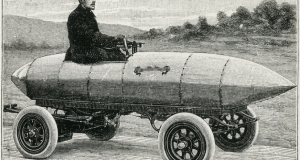Author: Ziwei Li
Engine torque ripple is essential for the comfort of vehicle passengers. Large torque ripple may result in a harsh driving experience. Moreover, additional noise and vibration are byproducts of torque ripple. The service life of the machine and attached components can be influenced by severe vibrations. Noise pollution is usually bothersome to passengers, aside from those few who like the roar of the engine. Unfortunately, many of these matters also apply to hybrid and pure electrical vehicles (EV). Without proper design and control of electrical machines, large torque ripple can persist and become unpleasant for passengers.
Therefore, it is necessary to develop technologies to reduce torque ripple for electrical machines used in EVs. In fact, this is always a hot topic among members of the industry and of the academy. After years of experimentation, two solutions are presented — machine control and machine design. For a new electrical machine product, it is natural to consider the torque ripple issues at the start phase of machine design. If the machine design cannot fulfill the torque ripple requirement, then one moves to the control aspect. Currently, if there is a problem with the machine design, then rotor shaping technologies are implemented to reduce the torque ripple. The rotor shaping technologies mainly include three methods– magnet shaping, rotor core shaping and skew.
Skew is the most well-known method among all rotor shaping technologies. As Figure 1 shows, the technique is not only applied on PM machines, but also applied on induction machines and reluctance machines. However, there are some well-known disadvantages for skew as well. For instance, the skewed rotor of PM machine normally requires a magnet with a very specific shape and strength of magnetization [1]. This complicates the design which increases the manufacture difficulty as well as the cost. In addition, the skew fundamentally reduces the winding factor, which reduces the output torque. The step of the skew has to be well calculated. Without the right skew step, the torque ripple can be even larger than in the case of a non-skewed rotor. Last but not the least, the skew is commonly achieved by using several rotor segments. This makes the rotor mechanical strength weaker than a solid rotor bar.
Fig. 1. (a) Step skewed rotor of a SPM machine [1]. (b) Three step skewed rotor of an IPM machine [2]. (c) Single skewed squirrel cage rotor of an induction machine [3]. (d) Skewed rotor of a synchronous reluctance motor [4].
Thus, in order to avoid the disadvantages of skew techniques, it is necessary to explore other technologies. Magnet shaping and rotor core shaping basically share the same idea of using sinusoidal geometry to reduce the distorted harmonics in the airgap. Since our focus is primarily on magnets, we provide an overall discussion of magnet shaping technologies below.
As is shown on Figure 2, the normal shape of a magnet product is rectangular (a) or a tile-shape magnet (b). Some shaped magnets can be breadloaf type, which is more sinusoidal, in contrast to tile-shaped magnets (c). Wave shape magnets with precisely controlled harmonics, as is shown on Figure 3, are also common. Moreover, the magnetization direction is normally in radial or parallel direction. However, recently, there are some novel inventions, such as Halbach array magnetization, Figure 2 (d).
Fig. 2 Different magnetization and magnet shaping: (a) Surface mounted radially magnetized tile-shape magnet. (b) Surface mounted parallel magnetized rectangular-shape magnet. (c) Surface mounted parallel magnetized bread loaf-shape magnet. (d) Halbach magnet array without iron back [5].
Fig. 3 Magnet shaping with harmonics injection: (a) Sinusoidal PM (bread loaf-shape). (b) Sinusoidal + 3rd PM [6]
The bread loaf-shape magnet can effectively reduce torque ripple. However, at the same time the average torque is also reduced due to lower fundamental harmonics, especially compared to tile-shape magnet. However, by injecting 3rd harmonics, or even higher harmonics, not only the torque ripple can be reduced, but also the average torque can be aligned with the tile-shape magnet, or even be higher [6].
But once again, the shaping of magnet can be costly as well. Sometimes with bad processing methods, such as over grinding or over polishing, the cost can be even higher than skew. Therefore, in order to make the magnet shaping techniques commercially viable, it is really important to find easy ways to shape magnets.
Fortunately, we found some promising techniques that can easily enable magnet shaping. More interesting is that these techniques seem to coincide with a magnet recycling concept. The first method is using segmented magnets. A breadloaf shape magnet can be divided into several segments, Figure 4 (a), (b).
Fig. 4 Segmented magnet poles: (a) A solid piece of bread loaf magnet. (b) Segmented bread loaf magnet. (c) Combined rectangular shape magnet. (d) Segmented magnet with recycling concept [7].
However, this kind of direct segmentation is costly to achieve. In order to make a compromise between cost and performance, normally the method shown in Figure 4 (c) is a good option. Some authors claimed that with standard size magnet segment, we can even achieve the direct-reuse of the magnets [7], Figure 4 (d). However, this is still on the concept level. Then the key issue is how many segments does it take to reach the most optimal quantity? Which kind of coating and glue is the best option for magnet assembly?
The second technique is so called magnet powder injection [8]. Simply said, it is a technique which mixes magnet powder together with a special binder, and this is directly injected into rotor container. Therefore, the difference between bonded magnet and this technique is the timing of the magnet formation—either before the injection or after the injection. When considering the recycling concept, the magnet powder can come from recycling routes, either directly recycled or indirectly recycled [9]. The shortcomings of the technique are almost the same with bonded magnet. Bonded magnets have lower remanence flux density than sintered magnets, due to addition of the non-magnetic binder. Besides, the magnet powder is normally isotropic and of a low coercivity. However, recently there is a new injection technology that can inject the magnet powder into the rotor without binder [10]. It simply uses a high pressure, or even auxiliary ultrasonic wave to make the powder compact. Thus, the remanence flux density can be highly improved. Meanwhile the authors [10] claimed that a special sealing technology have to be implemented to make sure the powder is not leaked out.
Even though the processing difficulties can be difficult to overcome, there are some other problems for magnet shaping. For instance, the demagnetization risk might be increased [11], due to the small thickness of both sides of bread loaf magnet. Besides, the coercivity of the injected magnet might be lower than ordinary magnets. And currently it is still unclear how magnet shaping may influence the eddy current in the magnet.
Nevertheless, magnet shaping technologies has opened a new window into the realm of machine designs in addition to skew. In the future, we can further investigate other more creative possibilities. With the advancement of 3D print, it will be possible to directly print out the magnet with any kind of shape, even magnetization you want. Actually something cool already appeared which is called printable magnets. If you don’t believe it, check the link [12]. Although, right now it is not feasible to have this printable magnet powering an EV, but why not in the future ? After all Alpha Go has already beaten human beings, not to mention some tricks using a small magnet, what else is possible?
- Bianchi, Nicola, and Silverio Bolognani. “Design techniques for reducing the cogging torque in surface-mounted PM motors.” IEEE Transactions on Industry Applications 38.5 (2002): 1259-1265.
- Ge, X., Zhu, Z. Q., Kemp, G., Moule, D., & Williams, C. (2017). Optimal Step-Skew Methods for Cogging Torque Reduction Accounting for Three-Dimensional Effect of Interior Permanent Magnet Machines. IEEE Transactions on Energy Conversion, 32(1), 222-232.
- Wang, C., Xu, S., Zhou, Y., Xu, W., & Chen, Y. (2017). Analysis of Vibration and Noise for Different Skewed Slot Type Squirrel-Cage Induction Motor. IEEE Transactions on Magnetics.
- Gan, C., Wu, J., Shen, M., Yang, S., Hu, Y., & Cao, W. (2015). Investigation of skewing effects on the vibration reduction of three-phase switched reluctance motors. IEEE Transactions on Magnetics, 51(9), 1-9.
- https://www.emetor.com/
- Wang, K., Gu, Z. Y., Zhu, Z. Q., & Wu, Z. Z. (2017). Optimum Injected Harmonics Into Magnet Shape in Multiphase Surface-Mounted PM Machine for Maximum Output Torque.IEEE Transactions on Industrial Electronics, 64(6), 4434-4443.
- Hogberg, T. S. Pedersen, B. B. Jensen, N. Mijatovic, J. Holboll, “Direct Reuse of Rare Earth Permanent Magnets -Wind Turbine Generator Case Study,”ICEM, 2016.
- http://www.veekim.com/images/E-Mobilityenglcompressed.pdf
- Binnemans, P. T. Jones, B. Blanpain, T. V. Gerven, Y. Yang, A. Walton and M. Buchert, “Recycling of rare earths: a critical review,” vol.51, p 1-22, Journal of Cleaner Production, 2013.
- https://patentscope.wipo.int/search/en/detail.jsf?docId=WO2010066251&recNum=1&tab=Drawings&maxRec=&office=&prevFilter=&sortOption=&queryString=
- Li, A. K. Lebouc, R. Fratila, J. Legranger, J. Dubus, A. Ikram, Investigation on surface mounted PM machines with magnet recycling concept for hybrid electrical vehicle applications, International Conference on Electrical Machines and Systems (ICEMS 2017), Sydney(Australia), August 2017
- https://kuleuven.sim2.be/category/erean//wordpress/the-magic-of-printable-magnets/

 European Training Network for the Design and Recycling of Rare-Earth Permanent Magnet Motors and Generators in Hybrid and Full Electric Vehicles (DEMETER)
European Training Network for the Design and Recycling of Rare-Earth Permanent Magnet Motors and Generators in Hybrid and Full Electric Vehicles (DEMETER)






